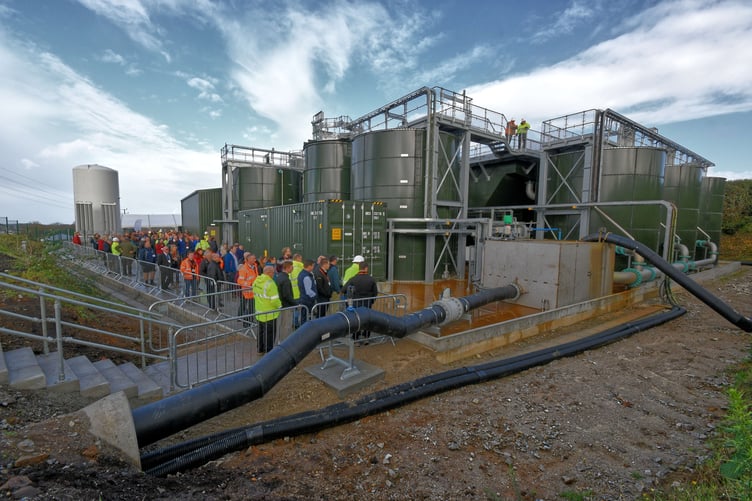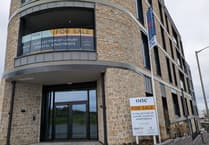Cornish Metals officially commissioned and opened their new water treatment plant on Thursday and are starting the process of dewatering the South Crofty mine.
The company said the new water treatment plant signifies a big leap forward to enable the historical, high-grade, underground tin mine to return to production after it closed back in 1998.
It has been a long journey to get to this point in the project and one which chief operating officer Owen Mihalop, who spoke to the Voice this week, has been involved with since its inception.
“When I first came to South Crofty about nine years ago, the company was in administration,” he said. “I worked with CEO Richard Williams to try and get the company out of administration and take it forward. At that time, we didn’t even have a permit to dewater the mine and treat any water, and that was the very first thing we tried to resolve back in 2016/17. We did water treatment trials and eventually got a permit from the environment agency by the end of 2017.
“We then raised a little bit of money, started the project, bought some equipment including dewatering pumps for the mine and began digging out the site where the water treatment plant was going to be built.
“We then went through a very difficult period in raising the rest of the money we needed to complete the project, so it was put on hold until around May last year. We were then fortunate to raise £40-million, principally from our biggest shareholder Vision Blue Resources. And with that money, we were able to restart the project.”
Dewatering of the mine is expected to take 18 months. Following successful wet commissioning of the water treatment plant and the building of a high-density sludge bed within it, discharge of treated water from South Crofty Mine to the Red River should commence this week at a rate of up to 25,000m3/day. The Red River currently receives untreated mine water as a legacy of past mining activities.
Owen explained: “The plant is designed to treat 25 cubic meters of water a day. But because in future we won’t have to treat so much, once the mine is dewatered and we go on to what we call ‘dewatering maintenance’ to keep the mine dry whilst we’re down there, it will only need to treat about a third of that.
“We’ve designed the plant to be three parallel streams so that in future we can reduce its capacity without affecting how it works.
“What we’re doing is trying to take out heavy metals from the water and those are principally iron, manganese, copper, zinc, all things that we find naturally in the ground and then come out in the water. The thing that people notice the most is iron, it gives the water a very red colour.”
Cornish Metals says it has taken “positive steps” to be able to combat its environmental impact. For instance, the water discharged from South Crofty powers a hydro-turbine which generates up to 15 per cent of the power consumed by the plant. Other renewable heat opportunities are being actively explored to make use of the treated water temperature, which is a steady 25°C all year round and has the potential to heat at least 800 homes in the local area.
Owen said: “What we try to do is work in the most responsible way we possibly can. The hydro-turbine is helping to reduce the amount of electricity we’re drawing off the grid.
“The electricity that we’re buying to power the plant has Renewable Obligations Certificates (ROC) and the supplier guarantees that it’s being generated from a carbon-neutral source.
“I think the biggest opportunity that we have going forward is to start to make use of the heat that is within the mine water, and that’s something we’re looking at now. The water itself is warm and there’s enough heat even when we’re running at one-third capacity which is what we will be doing in the future and for the rest of the mine life to heat 800 homes from that water treatment plant.
“We’re not at that stage yet, we’re right at the beginning of this part of the project, but that is the next phase and hopefully that will be something beneficial to the area.”
While resurrecting the mine, Cornish Metals have recruited people in Cornwall and collaborated with Cornish companies. The company hope to benefit residents living in the county by offering well-paid, skilled jobs to a minimum of 250 to 300 people when full production of the mine is in full-flow. The aim is to be in full production by late 2026, a target which Owen believes is going to be a challenge.
“The most important thing that people have to recognise is it’s dependent on how fast we can raise money. The £40- million that we raised last year is sufficient to dewater the mine and to complete our feasibility studies but it’s not the whole amount we need going forward but we’re actively working on that.
“To meet that end of 2026 target, we must expand our team and continue to raise the money to complete the rest of the project.
“We’re looking at three years in getting into production minimum. We need 18 months to dewater the mine and another 18 to get the underground mine ready for production and modernise it, while at the same time we have to build a processing plant on the surface. There’s a lot to do in a relatively short space of time.”
With the water treatment plant now open it provides another tick on the checklist in getting South Crofty Mine open in full production again.
Explaining what the next steps are for Cornish Metals, Owen added: “On the company side, we need to finalise our feasibility study and raise the money that we need to complete the rest of the project.
“On the operational side, our aim is to keep building our team of people so that we are in a position to deliver the project when we have the money to do it which hopefully is not too far away.”





Comments
This article has no comments yet. Be the first to leave a comment.